INSTITUT SUPERIEUR D'ANTHROPOLOGIE
INSTITUTE OF ANTHROPOLOGY
ONLINE COURSES / COURS A DISTANCE
INSCRIPTION 2012 / Session III : Juillet 2012
REGISTRATION 2012 / Term III : July 2012
ROYAUME UNI – 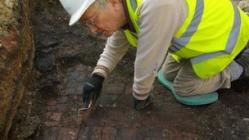 Gloucester - The ancient cloisters of Greyfriars Priory and the remains of a medieval tiled floor have been uncovered during an archaeological dig in Gloucester. Now the project has finished, the excavation site at Brunswick Road will be backfilled to preserve the cloister walls and medieval floor. "When you dig up a piece of medieval pottery or a piece of medieval glazed tile and you're the first person in 800 years to have seen it...it's what we all live for," added Mr Holbrook.
Gloucester - The ancient cloisters of Greyfriars Priory and the remains of a medieval tiled floor have been uncovered during an archaeological dig in Gloucester. Now the project has finished, the excavation site at Brunswick Road will be backfilled to preserve the cloister walls and medieval floor. "When you dig up a piece of medieval pottery or a piece of medieval glazed tile and you're the first person in 800 years to have seen it...it's what we all live for," added Mr Holbrook.
http://www.bbc.co.uk/news/uk-england-gloucestershire-17563613
USA – 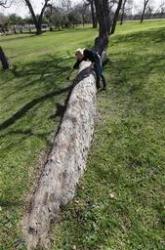
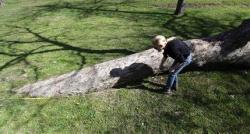 Dallas - The pecan tree, more than 300 years old, stands out from the others in a forested area of Dallas, a 25-foot segment of its trunk slightly bowed and running almost parallel to the ground before jutting high up into the sky. It, like numerous others across the country known as Indian marker trees or trail trees, was bent in its youth by American Indians to indicate such things as a trail or a low-water creek crossing. "If they could talk, the stories they could tell," said Steve Houser, an arborist and founding member of the Dallas Historic Tree Coalition. The trees, he said, "were like an early road map." The coalition has recognized four marker trees in Texas and is investigating reports of some 32 others across the state. The group also serves to celebrates the heritage the trees represent, Houser said. The Jasper, Ga.-based nonprofit Mountain Stewards has been compiling a database of the trees since 2007, documenting about 1,850 Indian marker trees in 39 states. Those who research the trees have a verification process, as they must be old enough — at least 150 to 200 years old. It also helps if scars can be found that would indicate it had been tied down. Sometimes, the researchers consult with tribes for confirmation.Trail trees don't adhere to one specific shape. In North Texas, the Comanches bent them in a low, half-moon shape that runs parallel to the ground before shooting up. In other places, the trees bend at a 90-degree angle a few feet from the ground with the trunk running parallel to the ground for a few feet before bending again up toward the sky.
Dallas - The pecan tree, more than 300 years old, stands out from the others in a forested area of Dallas, a 25-foot segment of its trunk slightly bowed and running almost parallel to the ground before jutting high up into the sky. It, like numerous others across the country known as Indian marker trees or trail trees, was bent in its youth by American Indians to indicate such things as a trail or a low-water creek crossing. "If they could talk, the stories they could tell," said Steve Houser, an arborist and founding member of the Dallas Historic Tree Coalition. The trees, he said, "were like an early road map." The coalition has recognized four marker trees in Texas and is investigating reports of some 32 others across the state. The group also serves to celebrates the heritage the trees represent, Houser said. The Jasper, Ga.-based nonprofit Mountain Stewards has been compiling a database of the trees since 2007, documenting about 1,850 Indian marker trees in 39 states. Those who research the trees have a verification process, as they must be old enough — at least 150 to 200 years old. It also helps if scars can be found that would indicate it had been tied down. Sometimes, the researchers consult with tribes for confirmation.Trail trees don't adhere to one specific shape. In North Texas, the Comanches bent them in a low, half-moon shape that runs parallel to the ground before shooting up. In other places, the trees bend at a 90-degree angle a few feet from the ground with the trunk running parallel to the ground for a few feet before bending again up toward the sky.
http://www.statesman.com/news/texas/groups-identify-trees-bent-by-american-indians-2274447.html
INDE - 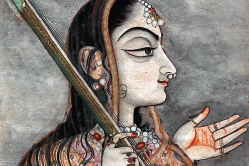 British painter Sir Gordon Howard Eliot Hodgkin’s interest in Indian paintings started in the late ’40s when he was still a schoolboy. Since then, it has become a vast collection. Oxford University’s first museum, Ashmolean Museum of Art and Archaeology, is currently displaying 115 works from the collection, most of which comprise paintings of the Mughal period (c 1550-1850). Titled Visions Of Mughal India: The Collection of Howard Hodgkin, the exhibition displays these works for the first time.Hodgkin’s India connection of 50 years comes not out of scholarly quest, but because, as he said, “I thought they were beautiful because they touched my emotions”. We see refined works of the imperial Mughal court, poetic paintings of the Deccan sultanates and styles of Rajput kingdoms of Rajasthan and Punjab Hills. In the last two decades, Hodgkin has acquired notable works such as the Bijapur portrait of Sultan Ali Adil Shah, among others. Although on in the UK, an online version of the show (jameelcentre.ashmolean.org/visions) has been presented by Eastern Art Online.
British painter Sir Gordon Howard Eliot Hodgkin’s interest in Indian paintings started in the late ’40s when he was still a schoolboy. Since then, it has become a vast collection. Oxford University’s first museum, Ashmolean Museum of Art and Archaeology, is currently displaying 115 works from the collection, most of which comprise paintings of the Mughal period (c 1550-1850). Titled Visions Of Mughal India: The Collection of Howard Hodgkin, the exhibition displays these works for the first time.Hodgkin’s India connection of 50 years comes not out of scholarly quest, but because, as he said, “I thought they were beautiful because they touched my emotions”. We see refined works of the imperial Mughal court, poetic paintings of the Deccan sultanates and styles of Rajput kingdoms of Rajasthan and Punjab Hills. In the last two decades, Hodgkin has acquired notable works such as the Bijapur portrait of Sultan Ali Adil Shah, among others. Although on in the UK, an online version of the show (jameelcentre.ashmolean.org/visions) has been presented by Eastern Art Online.
http://www.indianexpress.com/news/courtly-art/931480/
FRANCE – 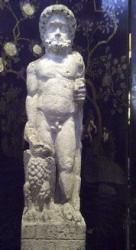 Avignonet-Lauragais - Barbu, tout nu, souriant, accompagné d'un aigle, le nouvel invité du musée des Antiques de Toulouse est attendu. Il arrive demain lundi de New York après plus d'un siècle de péripéties. Ce « Jupiter à l'aigle », statue de calcaire d'un mètre de haut, est la dernière acquisition de la Ville de Toulouse pour le musée Saint-Raymond. Une pièce unique dont on trouve trace dans le bulletin de la société archéologique du Midi de la France en 1903. Découverte dans un champ d'Avignonet-Lauragais un an plus tôt, en bordure du canal du Midi, elle a sans doute été volée avant de se retrouver dans des collections privées. En 1988, c'est un antiquaire américain qui en fait l'acquisition en même temps qu'un lot de meubles du XIXe siècle. « C'est amusant, et surréaliste. On a même entendu parler de soldat napoléonien, à cause de l'aigle ! Depuis, les Américains se sont bien rattrapés. C'est grâce au sérieux de la salle des ventes qu'on a pu dater et récupérer cette statue », rapporte Pascal Capus. L'assistant de conservation, spécialiste du monde romain au musée Saint-Raymond sera chargé d'étudier la statue. « On va regarder comment le calcaire a été travaillé. Elle vient certainement d'un atelier local et nous permettra peut-être d'imaginer qui étaient les sculpteurs de nos régions ». En attendant, Pascal Capus a déjà bien observé la statue à travers les photos qui ont suivi la vente aux enchères. « Esthétiquement parlant, ce Jupiter n'a pas de valeur. Il est joufflu et paraît souriant sous sa barbe et ses grosses boucles. Il est typique des ateliers provinciaux qui prenaient des libertés par rapport aux canons de Rome », poursuit Pascal Capus, heureux de recevoir une statue en aussi bon état. La statue, datée du troisième siècle, prendra place au deuxième étage du musée, avec la collection permanente de la section Tolosa qui rassemble les pièces de la Gaule narbonnaise.
Avignonet-Lauragais - Barbu, tout nu, souriant, accompagné d'un aigle, le nouvel invité du musée des Antiques de Toulouse est attendu. Il arrive demain lundi de New York après plus d'un siècle de péripéties. Ce « Jupiter à l'aigle », statue de calcaire d'un mètre de haut, est la dernière acquisition de la Ville de Toulouse pour le musée Saint-Raymond. Une pièce unique dont on trouve trace dans le bulletin de la société archéologique du Midi de la France en 1903. Découverte dans un champ d'Avignonet-Lauragais un an plus tôt, en bordure du canal du Midi, elle a sans doute été volée avant de se retrouver dans des collections privées. En 1988, c'est un antiquaire américain qui en fait l'acquisition en même temps qu'un lot de meubles du XIXe siècle. « C'est amusant, et surréaliste. On a même entendu parler de soldat napoléonien, à cause de l'aigle ! Depuis, les Américains se sont bien rattrapés. C'est grâce au sérieux de la salle des ventes qu'on a pu dater et récupérer cette statue », rapporte Pascal Capus. L'assistant de conservation, spécialiste du monde romain au musée Saint-Raymond sera chargé d'étudier la statue. « On va regarder comment le calcaire a été travaillé. Elle vient certainement d'un atelier local et nous permettra peut-être d'imaginer qui étaient les sculpteurs de nos régions ». En attendant, Pascal Capus a déjà bien observé la statue à travers les photos qui ont suivi la vente aux enchères. « Esthétiquement parlant, ce Jupiter n'a pas de valeur. Il est joufflu et paraît souriant sous sa barbe et ses grosses boucles. Il est typique des ateliers provinciaux qui prenaient des libertés par rapport aux canons de Rome », poursuit Pascal Capus, heureux de recevoir une statue en aussi bon état. La statue, datée du troisième siècle, prendra place au deuxième étage du musée, avec la collection permanente de la section Tolosa qui rassemble les pièces de la Gaule narbonnaise.
http://www.ladepeche.fr/article/2012/04/01/1320546-patrimoine-le-jupiter-a-l-aigle-revient-demain-a-toulouse.html